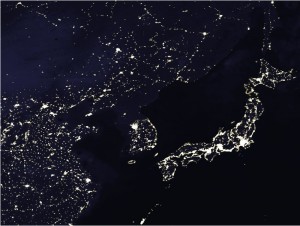For the United States, a nation battered and tired by a decade of conflict and two intractable wars, a period of retrenchment from world affairs has been pledged by the current administration. Unfortunately the world, as usual, is in no mood to cooperate. We have been entering for some time a dangerous season of instability and potential disaster driven by two authoritarian powers with aggressive desires and hostile intentions. We as a society ignore significant trends in these reactionary societies at our peril.
The obvious issue that binds the futures of western society and these two dictatorial powers is nuclear proliferation. Both regimes have been bent on developing a nuclear program with nuclear weapon capacity. North Korea, despite have one of the world’s most wretched economies has consistently invested in an expensive nuclear weapons process despite multiple declarations to the contrary. In 1994 North Korea jointly signed an agreement with the Clinton Administration to suspend its nuclear weapons program and agree to international atomic energy inspections in return for economic support and development of nuclear energy grid to supply electricity to impoverished population. In 2002, North Korea admitted it had violated all definitive aspects of the agreement and succeeded at plutonium extraction required for development of a nuclear explosive device. On October 9, 2006, North Korea achieved a small but successful explosion consistent with a nuclear device, an obvious abrogation of the previous 15 years of diplomacy. The efforts to achieve nuclear weaponry are at great odds to the nation’s stated desire to use nuclear sources for energy production, as a satellite view of North Korea at night compared to its neighbors attests.

Iran has been on a similar path, eliciting North Korean nuclear scientist expertise, to develop similar nuclear weapon capacity. Using much the same diplomatic tactics as North Korea, in claiming peaceful nuclear use while forging ahead with infrastructure for weapon development, Iran sits on the precipice of achieving nuclear weapon capacity. Diplomatics efforts by multiple nations to steer Iran away from nuclear weapons development have met with much the same success. Iran, despite having the the third largest oil reserve in the world, and producing 5% of the world’s current oil production, has determined to put its nation’s economy on hold in the effort to complete the nuclear weapons task.
Since 1949, with the Soviet Union’s successful testing of a nuclear device, the potential catastrophe of a nuclear exchange has been feasible , but constrained by the nuclear powers acknowledged capacity to annihilate each other, and the recognition of each as to the destruction of civilized society with such an exchange. September 11th, 2001, changed everything in the world’s understanding of rules of engagement, and the risks have therefore increased acutely. North Korea since 1950 has been ruled into the ground by a dictator and his son, with now a complete implosion of its economy and a starving population, ignored by a military machine that props up the regime and jealously lashes out at its hated genetic brothers, the South Koreans, for their obvious success in nationhood. The regime has no qualms about starting a major conflict, evidenced by the unprovoked torpedo sinking of the South Korea military vessel Cheonan, with the loss of 46 sailors on March 26 of this year. The North Korean’s propensity for irrational and dangerous statements to the world can not be taken lightly given their propensity for just such behavior. The Iranians have shown similar bluster, with repeated comments by the Iranian president Ahmadinejad to deny the Holocaust and promise the removal of the Isreali nation from the world map.
The blustering theats from both parties are unfortunately becoming a potentially realistic scenario as both have developed delivery systems capable of attacking both their local and regional enemies, and frankly, approaching the capacity to strike the United States and Europe. Iran has shown ballistic missile development in the Sejil- 2 missile with a 2500 kilometer range; North Korea is even farther along, with medium , and now long range missiles in the Taepodong series, reportedly capable of up to 10000 km range, approaching the distance between Pyongyang and Chicago. It is clear that the United States’ once safe oceanic separation from the world’s regional conflicts is a thing of the past.
The time is likely inevitable when both states will have the capacity for enormous damage and the irrational and messianic will to engage a crisis. How the civilized world responds to the threat before it reaches such proportions is the key question of our times. The United States is currently led by an administration that has cut funding for missile defense and purports that engagement and appeasement offer safer routes then confrontation to controlling the risks of the modern world. Such thinking has been on the wrong side of history since the sacrifice of Czechoslovakia to an dictator with insatiable allusions, and has continued in failures of logic as communist permanency , nuclear freeze, strategic missile reduction, military defense contracture, treaties of engagement with dictators, United Nation sanctions, apologies for perceived slights, and a myriad of other self absorbed illusions of means of peaceful co-existence. The manning of the ramparts to preserve the peaceful protection of the great achievements of western civilization against those dictators that would risk a dark age for their own survival is likely upon us in the coming months. Our will is being tested and our ability to respond before Danger’s Door, will determine whether this Dangerous Season marks an end to an era of human prosperity and liberty, or we hold on , one more time.